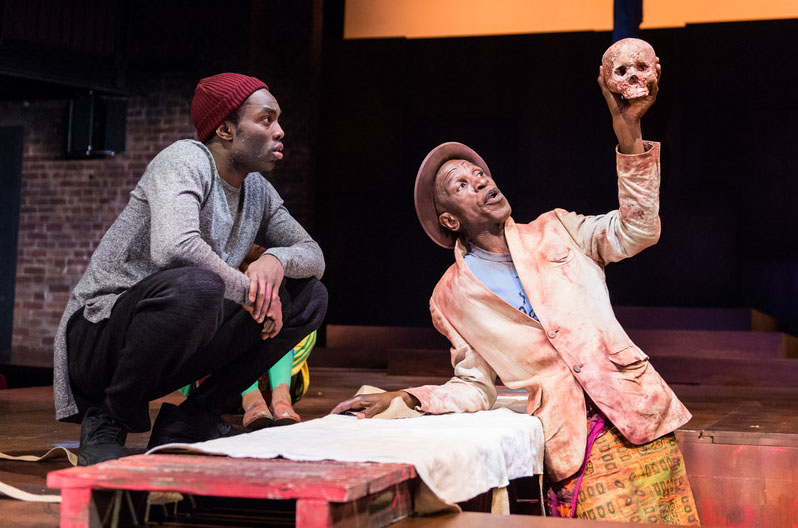
It’s a bit like wearying of sex with the same partner – out comes the well-thumbed copy of Kama Sutra, the fur hand-cuffs or the dressing-up box, anything for a bit of variety. That, I guess, you can understand and sympathise with, but surely nobody can be bored with Shakespeare – or at least you could assume the RSC couldn’t be. So why the constant dressing-up or search for new angles?
Now, I will be the first to admit to having seen and loved many strikingly original and amazingly liberal interpretations of the Bard over the years, whether they be Peter Brook’s Dream on a trapeze, all male versions, all female, posturing Berkoff, modern dress, Victorian and so on ad infinitum, but sometimes it can seem a bit arbitrary like a bored child in the middle of the long Summer holidays moaning, “Mum, what can I do?”
The RSC’s new Hamlet is patently original. Gone are the cliché blond Nordic tresses so favoured by Olivier and others, gone are the wind-swept rocky battlements of Elsinore and in are the brightly coloured Afro fabrics and pounding drums of medieval Denmark’s first black royal family.
Shakespeare is a bit like the Bible – a line in the text can always be found to justify any action or interpretation, but in this production are we supposed to ignore that the actors are black or that it is set in Denmark? You have to do one or the other. The fact that Hamlet is set in that country is mentioned twenty-three times throughout the play, not to mention that he is billed as Prince of Denmark. With the best will in the world (no pun intended) you can’t make Denmark into some tin-pot African (or was it Caribbean? there were accents from both) dictatorship.
With modern, liberal interpretations of the Bard you can ignore the odd line or reference that doesn’t quite fit and put it down to artistic license. In this production Polonius is shot with an automatic pistol rather than stabbed while behind the arras, fair enough, but you can’t have a poisoned gun for the fight scene and then resort to, as swords and daggers would have looked out of place, venomous pointy sticks.
To be fair, it started well. A high security area was patrolled by Bernardo and Marcellus, two heavily armed soldiers in camouflage battledress who, for some reason, were wearing what looked like UN blue berets. The haunting scenes all worked well, especially when the ghost rose from the swirling misty depths of the stage. I was quite happy to go with the flow and there was a lot I enjoyed but the longer it went on, the more the concept jarred. But this, luckily, was offset by some outstanding performances.
Paapa Essiedu is a very fine and energetic actor and gave this performance his all – and that was quite a lot. His Hamlet was full of astute observations and subtle nuances and he played mad to the hilt and occasionally to the gallery. This was a paint-spray wielding Hamlet in-da-hood with attitude, played largely for laughs and lapped up by the groups of teenage schoolgirls in the audience. Street cred he had . . .
Tanya Moodie was an excellent and very maternal Gertrude but you could see she always had her eye on the main chance and knew on which side her royal bread was buttered. I really liked sharp-suited Cyril Ni as the obsequious Polonius, always eager to please and smooth the troubled waters but, to my mind, the best performance came from Natalie Simpson as his daughter Ophelia. After a quiet start her descent into madness was heart-wrenching and for me her final couple of scenes were the high-spot of the show. Ewart James Walters shone as the gravedigger, one of those nice little Shakespeare cameos that afford such opportunities for scene stealing. So, on the whole, the acting was excellent, the charactersations believable and much of the staging impressive. And yet . . .
Shakespeare is always ripe for interpretation and is robust enough to withstand most liberties or stagings. There are many plays which are not so specifically rooted in a place or time as this one and an imaginative, clever director can virtually do what he or she wants with them. But there are other plays where the agenda is pretty much set in stone – Shylock has to be a Jew, Othello has to be a Moor, Richard III has to be a cripple and Hamlet has to be . . . well, Prince of Denmark.
For me Simon Godwin’s production of Hamlet was not totally successful and constituted one liberty too far – but still, there is always the possibility of an all-white Porgy and Bess to look forward to. ★★★☆☆ Michael Hasted 14th April 2016

